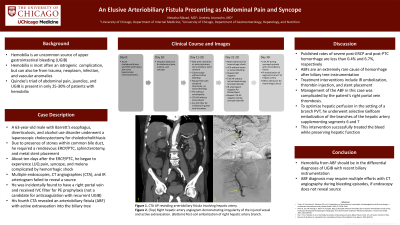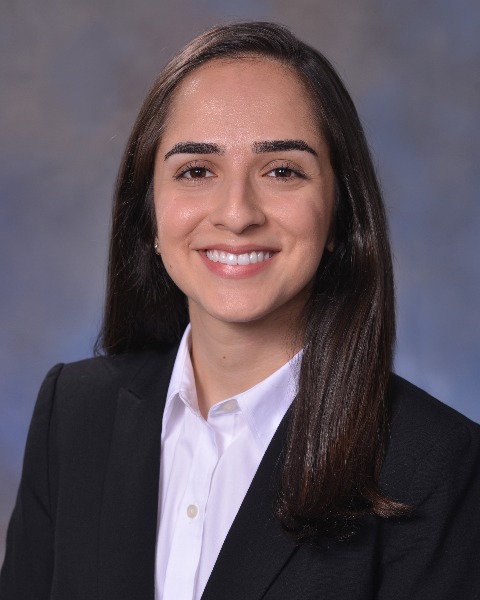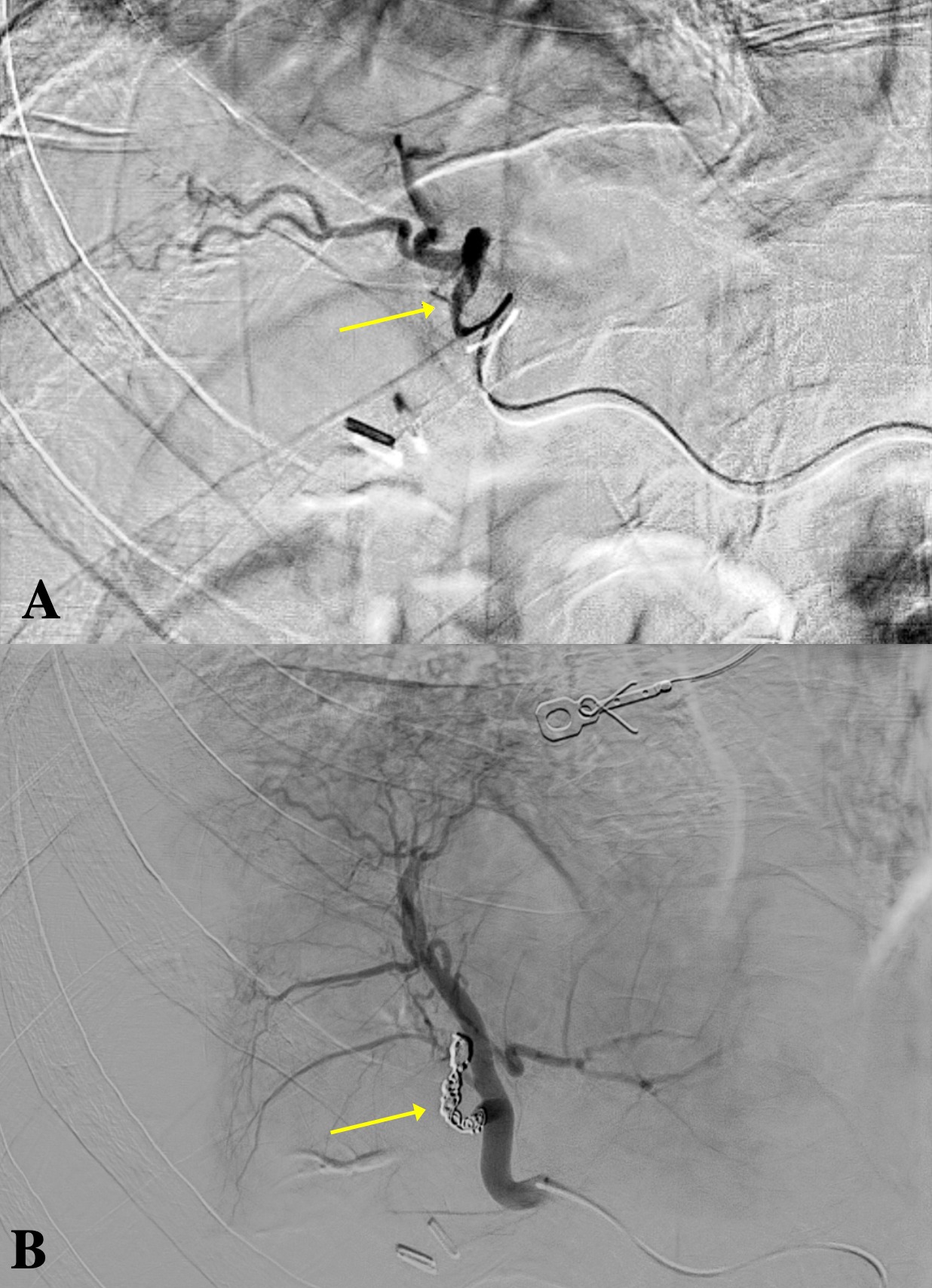Sunday Poster Session
Category: GI Bleeding
P0790 - An Elusive Arteriobiliary Fistula Presenting as Abdominal Pain and Syncope
Sunday, October 27, 2024
3:30 PM - 7:00 PM ET
Location: Exhibit Hall E

Has Audio

Newsha Nikzad, MD
The University of Chicago Medicine
Chicago, IL
Presenting Author(s)
Newsha Nikzad, MD1, Andrew Aronsohn, MD2
1The University of Chicago Medicine, Chicago, IL; 2University of Chicago Medicine, Chicago, IL
Introduction: Hemobilia is an uncommon source of upper gastrointestinal bleeding (UGIB) that is most often due to iatrogenic injury of the biliary tree, pancreas, liver, and their respective vasculature. Here, we present a rare case of intermittent hemobilia secondary to an arteriobiliary fistula (ABF) following endoscopic retrograde cholangiopancreatography (ERCP), percutaneous transhepatic cholangiogram (PTC), and sphincterotomy.
Case Description/Methods: A 63-year-old male with a history of Barrett’s esophagus, diverticulosis, and alcohol use disorder presented with recurrent episodes of left upper quadrant pain, syncope, and large-volume melena complicated by hemorrhagic shock. One month prior, the patient underwent rendezvous ERCP/PTC, sphincterotomy, metal stent placement, and laparoscopic cholecystectomy for choledocholithiasis. Symptoms began ten days following instrumentation. Initially, multiple endoscopies, CT angiographies (CTA), and an IR arteriogram failed to reveal an active source of bleeding even during symptomatic episodes. He was incidentally found to have a right portal vein thrombus requiring an inferior vena cava filter. Upon his fourth CTA, an ABF with active extravasation into the biliary tree and duodenum was visualized.
Discussion: The published rates of severe post-ERCP and post-PTC hemorrhage are less than 0.4% and 6.7%, respectively. While their incidence is not well-described in the literature, ABFs are an extremely rare cause of postoperative bleeding. Treatment interventions include IR embolization, thrombin injection, and stent placement. Management of the ABF in this case was complicated by the patient’s right portal vein thrombosis. Ultimately, the decision was made to Gelfoam embolize the branches of the hepatic artery supplementing segments 6 and 7, sparing the remainder of the liver and decreasing the risk of acute liver failure. Hemobilia from ABF should be in the differential diagnoses of UGIB in patients who have undergone recent biliary instrumentation. Importantly, identification of an ABF may require multiple diagnostic efforts with CT angiography during episodes of hemobilia, if endoscopy does not immediately reveal a source of bleeding.

Disclosures:
Newsha Nikzad, MD1, Andrew Aronsohn, MD2. P0790 - An Elusive Arteriobiliary Fistula Presenting as Abdominal Pain and Syncope, ACG 2024 Annual Scientific Meeting Abstracts. Philadelphia, PA: American College of Gastroenterology.
1The University of Chicago Medicine, Chicago, IL; 2University of Chicago Medicine, Chicago, IL
Introduction: Hemobilia is an uncommon source of upper gastrointestinal bleeding (UGIB) that is most often due to iatrogenic injury of the biliary tree, pancreas, liver, and their respective vasculature. Here, we present a rare case of intermittent hemobilia secondary to an arteriobiliary fistula (ABF) following endoscopic retrograde cholangiopancreatography (ERCP), percutaneous transhepatic cholangiogram (PTC), and sphincterotomy.
Case Description/Methods: A 63-year-old male with a history of Barrett’s esophagus, diverticulosis, and alcohol use disorder presented with recurrent episodes of left upper quadrant pain, syncope, and large-volume melena complicated by hemorrhagic shock. One month prior, the patient underwent rendezvous ERCP/PTC, sphincterotomy, metal stent placement, and laparoscopic cholecystectomy for choledocholithiasis. Symptoms began ten days following instrumentation. Initially, multiple endoscopies, CT angiographies (CTA), and an IR arteriogram failed to reveal an active source of bleeding even during symptomatic episodes. He was incidentally found to have a right portal vein thrombus requiring an inferior vena cava filter. Upon his fourth CTA, an ABF with active extravasation into the biliary tree and duodenum was visualized.
Discussion: The published rates of severe post-ERCP and post-PTC hemorrhage are less than 0.4% and 6.7%, respectively. While their incidence is not well-described in the literature, ABFs are an extremely rare cause of postoperative bleeding. Treatment interventions include IR embolization, thrombin injection, and stent placement. Management of the ABF in this case was complicated by the patient’s right portal vein thrombosis. Ultimately, the decision was made to Gelfoam embolize the branches of the hepatic artery supplementing segments 6 and 7, sparing the remainder of the liver and decreasing the risk of acute liver failure. Hemobilia from ABF should be in the differential diagnoses of UGIB in patients who have undergone recent biliary instrumentation. Importantly, identification of an ABF may require multiple diagnostic efforts with CT angiography during episodes of hemobilia, if endoscopy does not immediately reveal a source of bleeding.

Figure: (A) Right hepatic artery angiogram demonstrating irregularity of the injured vessel and active extravasation. (B) Post-coil embolization of right hepatic artery branch.
Disclosures:
Newsha Nikzad indicated no relevant financial relationships.
Andrew Aronsohn indicated no relevant financial relationships.
Newsha Nikzad, MD1, Andrew Aronsohn, MD2. P0790 - An Elusive Arteriobiliary Fistula Presenting as Abdominal Pain and Syncope, ACG 2024 Annual Scientific Meeting Abstracts. Philadelphia, PA: American College of Gastroenterology.

